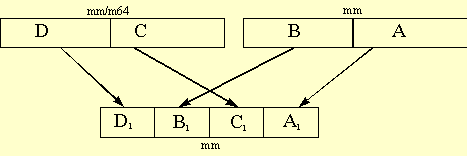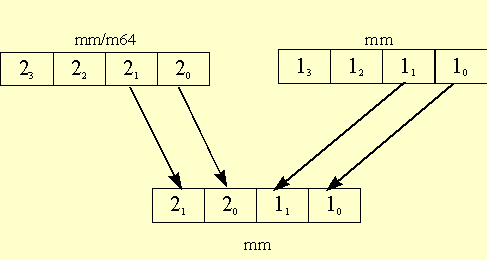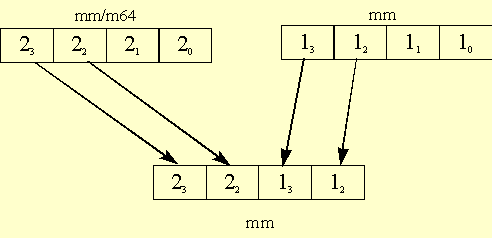![[INTEL NAVIGATION HEADER]](../../../../DESIGN/PIX/HEADER.GIF)

Chapter 5
MMX™ CODING TECHNIQUES
Coding Techniques
This section contains several simple examples that
will help you to get started in coding your application. The
goal is to provide simple, low-level operations that are frequently
used. Each example uses the minimum number of instructions necessary
to achieve best performance on Pentium(R) and P6-family processors.
- Each example includes:
- A short description.
- Sample code.
- Any necessary notes.
These examples do not address scheduling as we assume
you will incorporate the examples in longer code sequences.
5.1 Unsigned Unpack
The MMXTM technology provides several instructions
that are used to pack and unpack data in the MMX technology registers. The
unpack instructions can be used to zero-extend an unsigned number.
The following example assumes the source is a packed-word (16-bit)
data type.
Input: MM0 : Source value;
MM7 : 0
A local variable can be used instead of the register
MM7, if desired.
Output: MM0 : two zero-extended 32-bit doublewords from 2 LOW end words
MM1 : two zero-extended 32-bit doubleword from 2 HIGH end words
MOVQ MM1, MM0 ; copy source
PUNPCKLWD MM0, MM7 ; unpack the 2 low end words
; into two 32-bit double word
PUNPCKHWD MM1, MM7 ; unpack the 2 high end words into two
; 32-bit double word
5.2 Signed Unpack
Signed numbers should be sign-extended when unpacking
the values. This is done differently than the zero-extend shown
above. The following example assumes the source is a packed-word
(16-bit) data type.
Input: MM0 : source value
Output: MM0 : two sign-extended 32-bit doublewords from the two LOW end words
MM1 : two sign-extended 32-bit doublewords from the two HIGH end words
PUNPCKHWD MM1, MM0 ; unpack the 2 high end words of the
; source into the second and fourth
; words of the destination
PUNPCKLWD MM0, MM0 ; unpack the 2 low end words of the
; source into the second and fourth
; words of the destination
PSRAD MM0, 16 ; Sign-extend the 2 low end words of
; the source into two 32-bit signed
; doublewords
PSRAD MM1, 16 ; Sign-extend the 2 high end words of
; the source into two 32-bit signed
;doublewords
5.3 Interleaved Pack with Saturation
The PACK instructions pack two values into the destination
register in a predetermined order. Specifically, the PACKSSDW
instruction packs two signed doublewords from the source operand
and two signed doublewords from the destination operand into four
signed words in the destination register as shown in the figure
below.

Figure 5-1. PACKSSDW mm, mm/mm64 Instruction
Example
The following example interleaves the two values
in the destination register, as shown in the figure below.

Figure 5-2. Interleaved Pack with Saturation
Example
This example uses signed doublewords as source operands
and the result is interleaved signed words. The pack instructions
can be performed with or without saturation as needed.
Input: MM0 : Signed source1 value
MM1 : Signed source2 value
Output: MM0 : The first and third words contain the signed-saturated doublewords from MM0
MM0. The second and fourth words contain the signed-saturated doublewords from MM1
PACKSSDW MM0, MM0 ; pack and sign saturate
PACKSSDW MM1, MM1 ; pack and sign saturate
PUNPKLWD MM0, MM1 ; interleave the low end 16-bit values of the
; operands
The pack instructions always assume the source operands
are signed numbers. The result in the destination register is
always defined by the pack instruction that performs the operation.
For example, the PACKSSDW
instruction, packs each of the two signed 32-bit values of the
two sources into four saturated 16-bit signed values in the destination
register. The PACKUSWB
instruction, on the other hand, packs each of the four signed
16-bit values of the two sources into four saturated 8-bit unsigned
values in the destination. A complete specification of the MMX technology
instruction set can be found in the Intel Architecture MMX
TM Technology Programmers Reference Manual, (Order Number
243007).
5.4 Interleaved Pack Without Saturation
This example is similar to the last except that the
resulting words are not saturated. In addition, in order to protect
against overflow, only the low order 16-bits of each doubleword
are used in this operation.
Input: MM0 : signed source value
MM1 : signed source value
Output: MM0 : The first and third words contain the low 16-bits of the doublewords in MM0
: The second and fourth words contain the low 16-bits of the doublewords in MM1
PSLLD MM1, 16 ; shift the 16 LSB from each of the double
; words values to the 16 MSB position
PAND MM0, {0,ffff,0,ffff}
; mask to zero the 16 MSB of each
; doubleword value
POR MM0, MM1 ; merge the two operands
5.5 Non-Interleaved Unpack
The unpack instructions perform an interleave merge
of the data
elements of the destination and source operands into the destination
register. The following example merges the two operands into the
destination registers without interleaving. For example, take
two adjacent elements of a packed-word data type in source1; place
this value in the low 32-bits of the results. Then take two adjacent
elements of a packed-word data type in source2; place this value
in the high 32-bits of the results. One of the destination registers
will have the combination shown in Figure 5-3.

Figure 5-3. Result of Non-Interleaved
Unpack in MMO
The other destination register will contain the opposite
combination as in Figure 5-4.

Figure 5-4. Result of Non-Interleaved
Unpack in MM1
The following example unpacks two packed-word sources
in a non-interleaved way. The trick is to use the instruction
which unpacks doublewords to a quadword, instead of using the
instruction which unpacks words to doublewords.
Input: MM0 : packed-word source value
MM1 : packed-word source value
Output: MM0 : contains the two low end words of the original sources, non-interleaved
MM2 : contains the two high end words of the original sources, non-interleaved.
MOVQ MM2, MM0 ; copy source1
PUNPCKLDQ MM0, MM1 ; replace the two high end words of MM0
; with the two low end words of MM1
; leave the two low end words of MM0
; in place
PUNPCKHDQ MM2, MM1 ; move the two high end words of MM2 to the
; two low end words of MM2; place the two
; high end words of MM1 in the two high end
; words of MM2
5.6 Complex Multiply by a Constant
Complex multiplication is an operation which requires
four multiplications and two additions. This is exactly how the
PMADDWD instruction operates. In order to use this instruction
you need only to format the data into four 16-bit values. The
real and imaginary components should be 16-bits each.
Let the input data be Dr and Di where
Dr = real component of the data
Di = imaginary component of the data
Format the constant complex coefficients in memory
as four 16-bit values [Cr -Ci Ci Cr]. Remember to load the values
into the MMX technology register using a MOVQ instruction.
Input: MM0 : a complex number Dr, Di
MM1 : constant complex coefficient in the form[Cr-Ci Ci Cr]
Output: MM0 : two 32-bit dwords containing [ Pr Pi ]
The real component of the complex product is Pr =
Dr*Cr - Di*Ci, and the imaginary component of the complex product
is Pi = Dr*Ci + Di*Cr
PUNPCKLDQ MM0,MM0 ; This makes [Dr Di Dr Di]
PMADDWD MM0, MM1 ; and you're done, the result is
; [(Dr*Cr-Di*Ci)(Dr*Ci+Di*Cr)]
Note that the output is a packed word. If needed,
a pack instruction can be used to convert the result to 16-bit
(thereby matching the format of the input).
5.7 Absolute Difference of Unsigned Numbers
This example computes the absolute difference of
two unsigned numbers. It assumes an unsigned packed-byte data
type. Here, we make use of the subtract instruction with unsigned
saturation. This instruction receives UNSIGNED operands and subtracts
them with UNSIGNED saturation. This support exists only for packed
bytes and packed words, NOT for packed dwords.
Input: MM0: source operand
MM1: source operand
Output: MM0: The absolute difference of the unsigned operands
MOVQ MM2, MM0 ; make a copy of MM0
PSUBUSB MM0, MM1 ; compute difference one way
PSUBUSB MM1, MM2 ; compute difference the other way
POR MM0, MM1 ; OR them together
This example will not work if the operands are signed.
See the next example for signed absolute differences.
5.8 Absolute Difference of Signed Numbers
This example computes the absolute difference of
two signed numbers. There is no MMX technology instruction subtract which
receives SIGNED operands and subtracts them with UNSIGNED saturation.
The technique used here is to first sort the corresponding elements
of the input operands into packed-words of the maxima values,
and packed-words of the minima values. Then the minima values
are subtracted from the maxima values to generate the required
absolute difference. The key is a fast sorting technique which
uses the fact that B= XOR(A, XOR(A,B)) and A = XOR(A,0). Thus
in a packed data type, having some elements being XOR(A,B) and
some being 0, you could XOR such an operand with A and receive
in some places values of A and in some values of B. The following
examples assume a packed-word data type, each element being a
signed value.
Input: MM0: signed source operand
MM1: signed source operand
Output: MM0: The absolute difference of the signed operands
MOVQ MM2, MM0 ; make a copy of source1 (A)
PCMPGTW MM0, MM1 ; create mask of source1>source2 (A>B)
MOVQ MM4, MM2 ; make another copy of A
PXOR MM2, MM1 ; Create the intermediate value of the swap
; operation - XOR(A,B)
PAND MM2, MM0 ; create a mask of 0s and XOR(A,B)
; elements. Where A>B there will be a value
; XOR(A,B) and where A<=B there will be 0.
MOVQ MM3, MM2 ; make a copy of the swap mask
PXOR MM4, MM2 ; This is the minima - XOR(A, swap mask)
PXOR MM1, MM3 ; This is the maxima - XOR(B, swap mask)
PSUBW MM1, MM4 ; absolute difference = maxima-minima
5.9 Absolute Value
To compute |x|, where x is signed. This example assumes
signed words to be the operands.
Input: MM0 : signed source operand
Output: MM1 : ABS(MM0)
MOVQ MM1, MM0 ; make a copy of x
PSRAW MM0,15 ; replicate sign bit (use 31 if doing
; DWORDS)
PXOR MM0, MM1 ; take 1's complement of just the
; negative fields
PSUBS MM1, MM0 ; add 1 to just the negative fields
Note that the absolute value of the most negative
number (that is, 8000 hex for 16-bit) does not fit, but this code
does something reasonable for this case; it gives 7fff which is
off by one.
5.10 Clipping Signed Numbers to an
Arbitrary Signed Range [HIGH, LOW]
This example shows how to clip a signed value to
the signed range [HIGH, LOW]. Specifically, if the value is less
than LOW or greater than HIGH then clip to LOW or HIGH, respectively.
This technique uses the packed-add and packed-subtract instructions
with unsigned saturation, which means that this technique can
only be used on packed-bytes and packed-words data types.
The following example uses the constants packed_max
and packed_min.
The following examples shows the operation on word
values. For simplicity we use the following constants (corresponding
constants are used in case the operation is done on byte values):
- PACKED_MAX equals 0x7FFF7FFF7FFF7FFF
- PACKED_MIN equals 0x8000800080008000
- PACKED_LOW contains the value LOW in all 4 words
of the packed-words datatype
- PACKED_HIGH contains the value HIGH in all 4
words of the packed-words datatype
- PACKED_USMAX is all 1's
- HIGH_US adds the HIGH value to all data elements
(4 words) of PACKED_MIN
- LOW_US adds the LOW value to all data elements
(4 words) of PACKED_MIN
The examples illustrate the operation on word values.
Input: MM0 : Signed source operands
Output: MM0 : Signed operands clipped to the unsigned range [HIGH, LOW]
PADD MM0, PACKED_MIN ; add with no
; saturation 0x8000
; to convert to
; unsigned
PADDUSW MM0, (PACKED_USMAX - HIGH_US) ; in effect this clips
; to HIGH
PSUBUSW MM0, (PACKED_USMAX - HIGH_US + LOW_US) ;
; in effect
; this clips to LOW
PADDW MM0, PACKED_LOW ; undo the previous two
; offsets
The code above converts values to unsigned numbers
first and then clips them to an unsigned range. The last instruction
converts the data back to signed data and places the data within
the signed range. Conversion to unsigned data is required for
correct results when the quantity (HIGH - LOW) < 0x8000.
IF (HIGH - LOW) >= 0x8000, the algorithm can
be simplified to the following:
Input: MM0 : Signed source operands
Output: MM0 : Signed operands clipped to the unsigned range [HIGH, LOW]
PADDSSW MM0, (PACKED_MAX - PACKED_HIGH) ;in effect this
; clips to HIGH
PSUBSSW MM0, (PACKED_USMAX - PACKED_HIGH + PACKED_LOW) ;clips to LOW
PADDW MM0, LOW ;undo the
;previous two
;offsets
This algorithm saves a cycle when it is known that
(HIGH - LOW) >= 0x8000. To see why the three instruction algorithm
does not work when (HIGH - LOW) < 0x8000, realize that 0xffff
minus any number less than 0x8000 will yield a number greater
in magnitude than 0x8000 which is a negative number. When
PSUBSSW MM0, (0xFFFF - HIGH + LOW)
(the second instruction in the three-step algorithm)
is executed, a negative number will be subtracted causing the
values in MM0 to be increased instead of decreased,
as should be the case, and causing an incorrect answer to be generated.
5.11 Clipping Unsigned Numbers to an Arbitrary Unsigned Range [HIGH, LOW]
This example clips an unsigned value to the unsigned
range [HIGH, LOW]. If the value is less than LOW or greater than
HIGH, then clip to LOW or HIGH, respectively. This technique uses
the packed-add and packed-subtract instructions with unsigned
saturation, thus this technique can only be used on packed-bytes
and packed-words data types.
The example illustrates the operation on word values.
Input: MM0 : Unsigned source operands
Output: MM0 : Unsigned operands clipped to the unsigned range [HIGH, LOW]
PADDUSW MM0, 0xFFFF - HIGH ; in effect this clips to HIGH
PSUBUSW MM0, (0xFFFF - HIGH + LOW) ; in effect this clips to LOW
PADDW MM0, LOW ; undo the previous two offsets
5.12 Generating Constants
The MMX technology instruction set does not have an instruction
that will load immediate constants to MMX technology registers. The following
code segments will generate frequently used constants in an MMX technology
register. Of course, you can also put constants as local variables
in memory, but when doing so be sure to duplicate the values in
memory and load the values with a MOVQ instruction.
Generate a zero register in MM0:
PXOR MM0, MM0
Generate all 1's in register MM1, which is -1 in
each of the packed data type fields:
PCMPEQ MM1, MM1
Generate the constant 1 in every packed-byte [or
packed-word] (or packed-dword) field:
PXOR MM0, MM0
PCMPEQ MM1, MM1
PSUBB MM0, MM1 [PSUBW MM0, MM1] (PSUBD MM0, MM1)
Generate the signed constant 2n -1 in
every packed-word (or packed-dword) field:
PCMPEQ MM1, MM1
PSRLW MM1, 16-n (PSRLD MM1, 32-n)
Generate the signed constant -2n in every
packed-word (or packed-dword) field:
PCMPEQ MM1, MM1
PSLLW MM1, n (PSLLD MM1, n)
Because the MMX technology instruction set does not support
shift instructions for bytes, 2n-1 and -2n are
relevant only for packed-words and packed-dwords..
Legal Stuff © 1997 Intel Corporation





